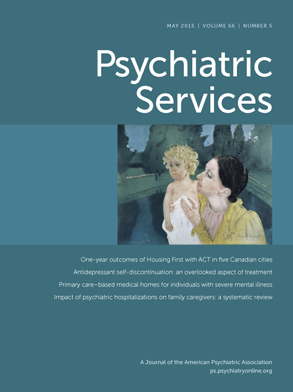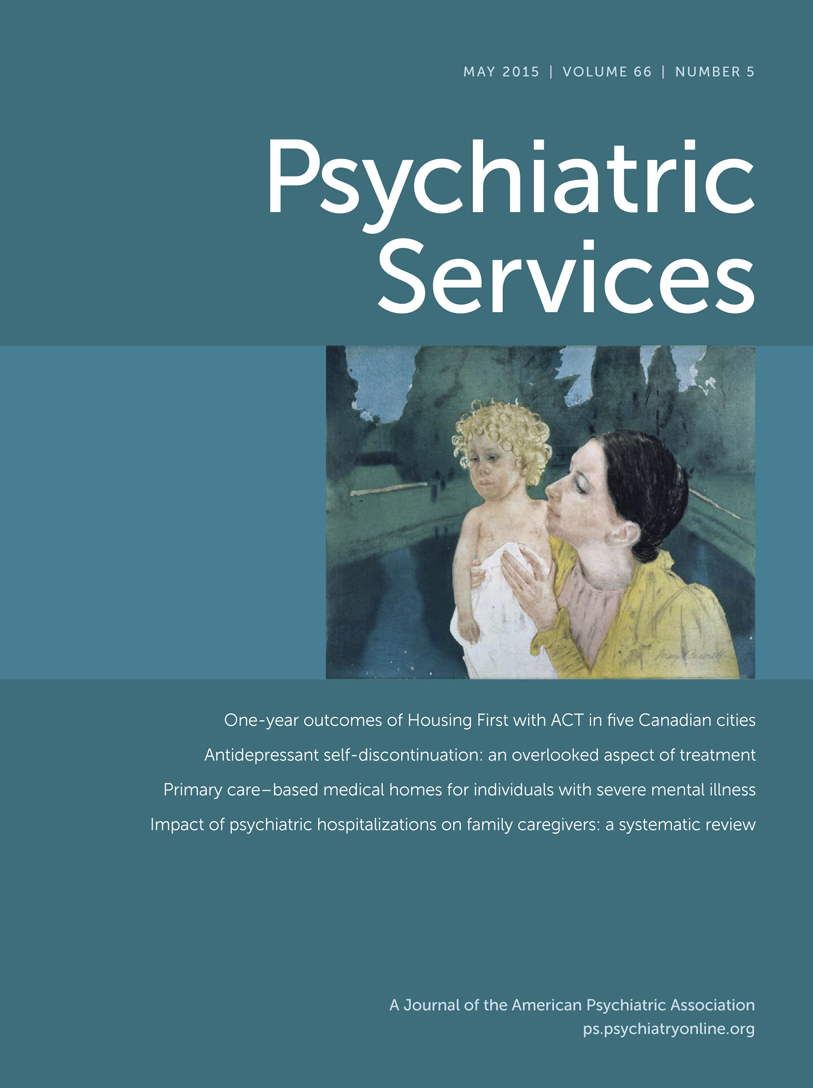Previous studies have indicated that 2% to 18% of adult patients who repeatedly visited psychiatric emergency services generated 21% to 65% (
1–
5) of the total clinical activity in these settings. Recurrent use of emergency services is a significant cost burden (
6,
7). Prevalence rates of recurrent visits depend on how researchers define recurrence (
8); however, frequent visits raise the question of which modalities are best adapted to psychiatric emergency care. Although deinstitutionalization is an important trend in psychiatric care (
9), an increasing number of patients seek psychiatric care from emergency services (
10).
Authors of past studies have defined frequent visits arbitrarily, with no consensus about the definition. Some have defined frequent visits as more than two above the mean standard deviation (
1,
2), and some have used the upper tenth percentile of the sample (
4). Others have defined frequent visits as one visit (
3) or six visits (
2,
7) per year, four visits in a quarter (
2), or at least six visits in six years (
11). Moreover, sample characteristics differ between studies, and some studies have limited the sample to patients with specific diseases, such as psychotic disorders (
11), or to “incident” patients (that is, those newly detected as recurrent visitors) with no previous visits to psychiatric services (
4). Unfortunately, previous investigations have focused mainly on recurrent visits over the short term, usually within a single year. To date, only a few studies have extended their follow-up to longer periods (
1–
4,
11).
Several studies have attempted to identify clinical and sociodemographic characteristics of frequent users of psychiatric emergency services. Frequent visitors were mostly men (
1–
4,
7,
12) and lived in a more precarious socioeconomic environment (
1,
2,
4,
5,
7,
8,
11). Some studies have established that frequent visitors were younger (
3,
11,
12), contrary to other studies (
1,
4). Frequent visitors were more likely to have a diagnosis of a personality disorder (
1–
3,
10) or of schizophrenia or another psychotic disorder (
1,
3,
11,
12); they were also found to have more severe psychiatric symptoms (
4). Several authors found an association between frequent visits and having a substance use disorder (
8,
11,
12), whereas others did not (
7) or considered this relationship to be dependent on the severity of patients' clinical status (
5). Finally, a history of previous psychiatric hospitalizations, greater use of various types of psychiatric and nonpsychiatric health services, and more intense utilization of regional mental health services have been found to be related to frequent visits (
2,
7).
Recurrent visits to emergency services by patients whose condition is not urgent can result in negative attitudes toward patients and avoidance reactions among the staff of emergency services, which some have attributed to emergency staff members’ lack of confidence in their ability to manage patients who make frequent visits (
10). Development of specific care models for these patients requires identification of their characteristics. Thus we assessed sociodemographic and diagnostic characteristics that predicted recurrent visits. To address the lack of longer follow-up in previous studies, we conducted a three-year retrospective study of community-dwelling patients who visited psychiatric emergency services. We compared patients who stopped making frequent visits (three or more per year) after one year with those who made recurrent visits for more than one year. In addition, we included both patients who were newly detected as recurrent visitors (“incident” group) and those who were known to be recurrent visitors at study entry (“prevalent” group). We hypothesized that frequent use of psychiatric emergency services in itself would predict recurrent use over the next three years.
Discussion
To our knowledge, this is the first study to focus on the prevalence rate and sociodemographic and clinical determinants of frequent visits to psychiatric emergency services in Switzerland. A unique feature is its focus on a highly urban area in which extensive outpatient psychiatric care is available in both public and private settings. The study traced the evolution of recurrent use of psychiatric emergency services over a three-year period. In the absence of a consensus regarding the definition of frequent visits, we decided to follow the arbitrary criterion of three or more visits per year used by Saarento and colleagues (
4) because of its clinical relevance in the context of our study.
We found that among patients who had three or more visits in the first year, 13% also had three or more visits in the second year. However, this rate dropped to 5% after two years and remained stable in the third year (4%). These findings stress the importance of extending the duration of longitudinal studies beyond one year to identify the subpopulation with chronically high use and to develop appropriate care alternatives for this vulnerable group.
In contrast with previous findings (
1–
4,
11), sociodemographic factors, such as age, gender, marital status, professional activity, and citizenship, did not predict recurrent visits over three years. As in the study by Schmoll and colleagues (
1), which found no gender or age effect, our findings suggest that specific sociodemographic profiles are insufficient to distinguish frequent visitors to emergency psychiatric services. In addition, being foreign born (not a Swiss citizen) was not a significant predictor, contrary to previous findings (
15). Therefore, lack of formal social support, financial status, and race-ethnicity may not be the only determinants of long-term recurrent use of psychiatric emergency services, despite evidence from previous studies (
1,
2,
4,
5,
7,
8,
11). However, the generalizability of our results depends on country-specific health insurance systems. Indeed, the mandatory insurance system in Geneva covers emergency psychiatric services to the same level as treatment in other specialized psychiatric settings, even for patients who lack financial resources. Patients are generally free from financial restraints in their treatment options. This might explain the difference between our findings and those of Arfken and colleagues (
7), who found an association between frequency of emergency service visits and low financial resources. Unlike our study, their study was conducted in a disadvantaged area, in an emergency service facing the challenge of providing high-quality psychiatric care in a resource-poor environment.
A personality disorder diagnosis predicted recurrent visits, which strengthens previous evidence (
1–
3,
11). Notably, a diagnosis of borderline personality disorder was a significant predictor. The prevalence of this disorder may be underestimated because it is frequently misdiagnosed and underdiagnosed even by highly skilled psychiatrists and because it is often comorbid with other mental disorders, such as bipolar disorder (
16,
17). Borderline personality disorder makes the therapeutic or helping alliance hard to establish and maintain (
18), which suggests that having this diagnosis may be related to interpersonal difficulties in general and may explain why it was a significant predictor of recurrent visits. In support of this idea, Arfken and colleagues (
7) reported that frequent visitors to an emergency psychiatric service were less likely than other patients to be able to provide the name of a family member or friend.
As noted, in Geneva patients can be admitted to a psychiatric inpatient unit or referred to specialized outpatient crisis services by their psychiatrist or general practitioner. Therefore, frequent visitors do not have to rely on psychiatric emergency services of the general hospital. However, not all frequent visitors to emergency services seek care in traditional outpatient settings, because some may have difficulties with the organizational constraints of such settings. Indeed, previous studies reported that frequent visitors used psychiatric emergency services because of their convenient location and because no appointment was required (
7). Further research on features of psychiatric emergency services that facilitate their access and use is warranted to explore this issue.
Our finding of a significant difference between patients in the prevalent and incident groups over the three-year follow-up confirmed the necessity of taking into account a patient’s pattern of visits before study entry. Our hypothesis that the repeated use of psychiatric emergency services in itself may predict recurrence was partly confirmed—the prevalent nature of the visits, but not their number, predicted their recurrence. Patients who had visited the UAUP three or more times per year in the 18 months before study entry were three times more likely than other patients to have three or more repeat visits per year in the following three years. These findings complement those of Saarento and colleagues (
4), who concluded that an initial visit does not predict future visits; our study underscored that past repetition predicts future repetition. Seeking psychiatric treatment in nonemergency settings was not associated with recurrent visits to the UAUP.
From a clinical point of view, a promising alternative to simply reducing the number of emergency visits is the creation within the psychiatric emergency service setting of specialized programs specifically adapted to the needs of frequent visitors. Frequent visitors establish therapeutic alliances with many different caregivers in the emergency service, which is open 24 hours a day, seven days per week, with no requirement to make an appointment or other commitments. Others have pointed out that a significant number of frequent users do not seek treatment from outpatient services but regularly visit psychiatric emergency services on their own initiative (
8). Psychiatric emergency services typically offer clinical assessment, crisis counseling, and orientation; such services should also consider offering patients the option of engaging in follow-up treatment on site, such as flexible individual sessions or once-a-week open group sessions focusing on crisis work. Ensuring that frequent visitors comply with recommended aftercare is also important, because noncompliance with aftercare is associated with shorter intervals between repeat visits (
8).
This study had methodological limitations. First, the size of the sample did not allow us to define a more complex regression model to integrate variables such as precariousness (homelessness and receipt of financial assistance) or occurrence of stressful live events. Similarly, the small sample did not allow for more nuanced analyses of demographic characteristics of patients with recurrent visits in 2010 and 2011. Without replicating the results in a larger sample, we cannot know whether the percentage fluctuations in gender and citizenship status merely reflect a lack of stability in time or reveal actual differences between the nonrecurrent and the recurrent groups. Second, at the initial screening, 17% of the patients who were found to need both general medical and psychiatric care (for example, for abuse of drugs, care of wounds caused by self-injury, or binge drinking) were referred for a general medical assessment and were not included in the study. This may have led to an underestimation of the number of patients with recurrent visits. Finally, even though all psychiatric diagnoses were made under the supervision of a senior psychiatrist, the additional use of traditional, semistructured interviews would have been preferable.

